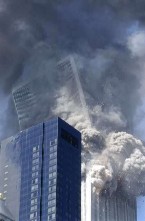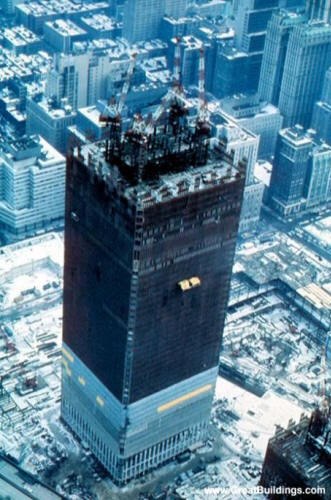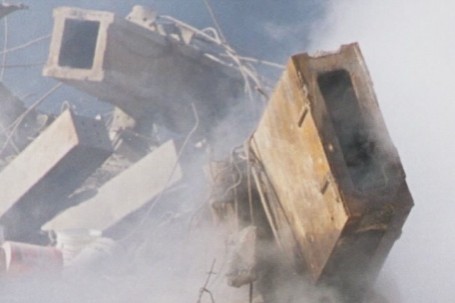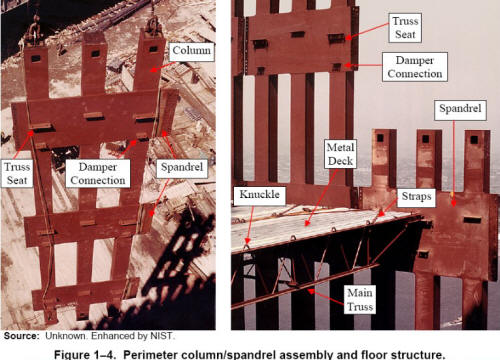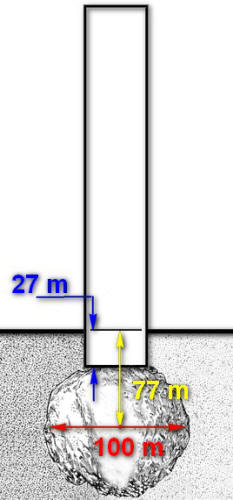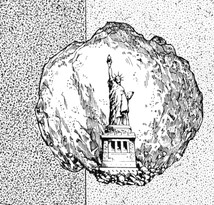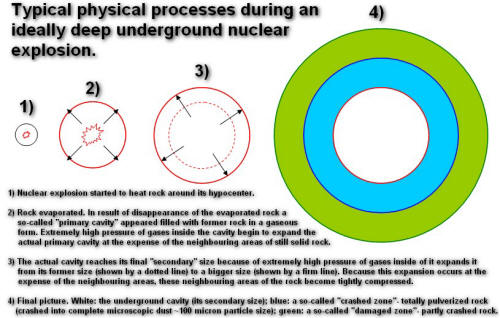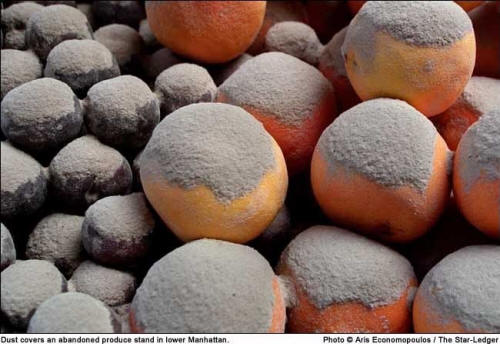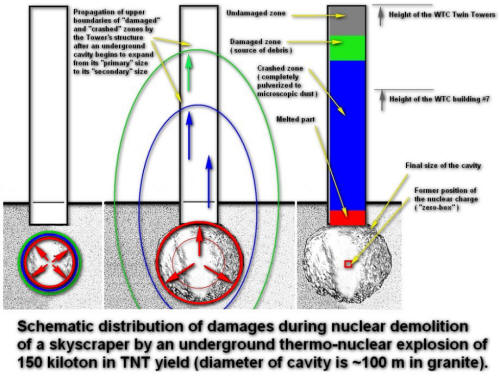|
from Nuclear-Demolition Website
This article describes a general concept of nuclear demolition of skyscrapers - particularly in connection with known thermo-nuclear demolition schemes of the World Trade Center in New York and that of the Sears Tower in Chicago.
Though, the current article does not deal with any exact details of implementation of this concept in regard to these particular structures, but provides rather general knowledge on this subject.
Besides, this article does not consider any conspiracy behind nuclear demolition of the WTC on 9/11, neither does it consider any moral aspect of this issue - such as ground zero clean-up works and so on - it aims to explain its purely technical aspect.
South Tower begins to collapse.
However, there are other articles
available in the Internet that describe the WTC nuclear demolition
scheme in more or less exact detail, as well as articles that
describe particular conspiracy in regard to the actual WTC
demolition - links to these articles are available at the end of the
current description.
The same company was a primary designer of nuclear demolition
projects of the World Trade Center in New York and of the Sears
Tower in Chicago.
At first nuclear munitions were not called "nuclear", but "atomic", so a concept of demolition using these munitions was called accordingly - "atomic demolition". These words managed to survive and despite renaming former atomic weapons into "nuclear weapons", words "atomic demolition" could still be encountered today in names of special engineering devices - SADM and MADM.
The first one stands for "Special Atomic
Demolition Munitions", the second - for "Medium Atomic Demolition
Munitions", while many people mistakenly believe that SADM means
"Small Atomic Demolition Munitions", rather than "Special".
Other popular names for these Small Atomic Demolition Munitions are "mini-nuke" and "suite-case nuke", though the second one is probably not logically correct.
In reality most of SADM resemble big pots weighing between 50 to 70 kilograms that could be carried as back-packs - so it is very unlikely that they could fit into any suite-case.
However, there are also modern "mini-nukes" made of Plutonium-239, rather than of Uranium-235, and due to a much lower critical mass of Plutonium, their size could be significantly decreased - some latest Plutonium-based "mini-nukes" could indeed fit into an attaché-case.
Medium Atomic Demolition Munitions (MADM)
are bigger in both - their size and their TNT yield. They could be
up to 15 kiloton in TNT yield, weigh up to 200 kg and be as big as a
typical large gas-cylinder for home use.
For example, it could be bridges, dams, tunnels, some reinforced underground structures, large reinforced buildings, etc. However, an efficiency factor for such nuclear demolitions using SADM or MADM is not too high.
As it is probably known, the main aim of controlled demolition of buildings by implosion method is not to actually eliminate these buildings by blowing them up and sending their parts flying around, but to bring them down neatly with the least possible damage to surroundings.
For this reason engineers who prepare controlled demolitions have to first figure out exact points on buildings bearing structures and attach charges of conventional explosives to the right spots - in order to break these bearing structures.
In almost all cases there would be more than one spot to attach explosives, since it is unlikely that any of such structures would have only a single supporting girder or a single supporting column that it is to be broken; at best case there would be a few of them, if not many. In case with nuclear demolition using abovementioned atomic demolition munitions it is not the case.
People who suppose to use atomic munitions in case of emergency would have neither time, nor enough education to make such precise calculations as in case of a conventional controlled demolition. Maximum of what these people could have - is some basic field-engineering knowledge and some basic knowledge in regard to nuclear weapons usage.
Thus, usage of atomic demolition munitions in such case is to bring down a targeted structure not "neatly", but just anyhow and at any cost. That is why an explosive yield of atomic munitions used to demolish such structure in case of emergency in any case would be excessive, with major part of their entire explosive energy spent in vain - as in case with any other nuclear explosion.
So, the major part of energy, released by a nuclear explosion of such an atomic demolition device would be spent on creating well-known factors of atomic blast:
...that have nothing to do with the actual demolition task and could unlikely contribute to it.
However, all these destructive factors of an atomic explosion would greatly contribute to damaging of the surroundings - and this damage could be rather extreme, definitely exceeding in its cost a cost of the actual demolition.
It could be said that a nuclear demolition in the abovementioned sense would have much lower performance index compare to a precisely calculated conventional controlled demolition, since the latter one directs almost entire energy of explosives used on breaking bearing structures, rather than on creating an air-blast wave or a thermal radiation.
Besides of this, an atomic demolition device itself is quite a costly thing too. At minimum, a Uranium-based "mini-nuke" costs a couple of million US dollars, if not more (a Plutonium-based one costs much more than that). Apparently, a thousand tons of TNT would cost cheaper than a 1 kiloton atomic munitions.
However, it is possible to demolish quite a few buildings using 1000 tons of TNT, while it is possible to demolish only one single building (but to damage many other buildings around) using a "mini-nuke". Considering all of this, it could be concluded that it is not an option - to use any atomic demolition munitions, either small, or medium, for demolishing any civil infrastructure in times of peace when there is enough time to prepare demolishing any of such objects nicely by conventional means.
And in any case a conventional
controlled demolition would be cheaper than a nuclear demolition.
Mini-nukes could only be used for demolition job in case of real
emergency.
It happens because of a new generation of buildings has come into existence at the end of 60s - namely steel-framed buildings. Despite common misconception, there were no steel-framed skyscrapers ever been demolished by an implosion anywhere in the world.
Primarily, because the most of skyscrapers are new buildings and their time to be demolished has not come yet. The tallest building ever demolished by an implosion was only 47-strories high - it was the Singer Building in New York City that was built in 1908 and demolished in 1968 due to its being obsolete. This building was a much weaker structure compare to incredibly strong hollow-tube type steel-frame skyscrapers being built today.
So, despite common misconception, it is not possible to demolish a steel-frame building by a commonly known controlled demolition (implosion) scheme. In bygone days when buildings were brick-walled and concrete-paneled, their bearing structures used to be concrete supporting columns and concrete supporting girders.
Sometimes these concrete bearing structures were reinforced by insertions of metal bars, but sometimes they were plain concrete. In either case it was possible to calculate right amount of conventional explosives to be attached to these bearing structures at right spots (or to be placed into holes drilled in bearing structures) in order to break them all at once and to cause the building to collapse into its footprint.
However, it is no longer possible with
modern steel-framed buildings - such as, for example former Twin
Towers of the New Your World Trade Center, World Trade Center
building # 7, or the Sears Tower in Chicago.
WTC Twin Tower under
construction. There was no any "bearing structure" in its former sense - the entire Tower was essentially a "bearing structure".
The WTC steel-frame consisted of exceptionally thick double-walled steel perimeter and core columns. This co-called "tube-frame design" was a totally new approach which allowed open floor plans rather than columns distributed throughout the interior to support building loads as it was traditionally implemented in previous structures.
The Twin Towers featured load-bearing perimeter steel columns (square in cross-section) positioned one meter from each other on the Towers' facades to form an exceptionally rigid structure, supporting virtually all lateral loads (such as wind loads) and sharing the gravity load with the core columns. The perimeter structure contained 59 such columns per side.
The core structure of the Tower consisted of 47 rectangular steel columns that run from the bedrock to the Towers' tops.
How such steel perimeter and core columns looked like could be seen from this picture showing some remnants of these columns as found on the ground zero after the WTC demolition following the September 11 attacks:
WTC core and
perimeter columns. Note that these core (rectangular) and perimeter (square) columns did not belong to lower parts of the Twin Towers, but to their upper parts.
That is why they were spared by general
pulverization the Towers were subjected to during their demolitions,
while virtually nothing, except microscopic dust remained of similar
columns belonging to the lower parts of the Twin Tower structure.
Twin Towers perimeter
structures. These steel columns were incredibly thick - each wall measuring 2.5 inch (6.35 cm), so the entire thickness of either of the columns was 5 inch (12.7 cm).
To imagine how thick this is, here is a good example to compare with: front armor of the best tank of the WWII period - T-34 - was only 1.8 inch (4.5 cm) and it was single-walled. Yet there were practically no armor-piercing artillery shell available that time that would be capable of penetrating such front armor.
Of course, no explosives whatsoever would ever be able to tear throw such front armor of a tank either (except only a hollow-charge shell which would still not be able to tear a complete piece of such armor, but only to burn some narrow hole through an armor plate).
Considering that the Twin Towers' steel frames consisted of double-walled steel columns that were almost trice as thick compare to the T-34 tanks' front amour, it would not be possible to find any solution to break such columns simultaneously in many spots in order to achieve an "implosion" effect - the basic goal of any controlled demolition.
It was, of course, technically possible to break some of these columns in certain spots, using exceptionally huge amounts of hollow-charges attached to each individual column, but even such an incredible solution would not help to achieve the desired "implosion effect".
The Towers were simply too high and too rigid - their steel cores would have been simultaneously broken in too many spots on every floor, which no one could afford.
And even if they could, still, such a solution would not lead to the desired effect - there would not be any guarantee that such a high-raised structure would fall strictly down to its foot print - it might as well scatter its debris as far as a quarter of a mile, considering its mere height.
So, it was
impossible to bring the WTC Towers down by any kind of traditional
controlled demolition.
However, in accordance with the US laws governing construction of skyscrapers buildings designers had to submit some satisfactorily demolition project before their construction project could be approved by the Department of Buildings. No one could be allowed to build a skyscraper that can't be demolished in the future. This is the main point of the skyscrapers' in-built nuclear demolition features.
Ironically, such a nuclear demolition scheme of a skyscraper is not meant to actually demolish the respective skyscraper, especially considering that no one has any practical experience in demolishing skyscrapers by such means - it is only intended to convince the Department of Buildings to permit the skyscraper's construction whatsoever.
It appears that
all designers and proponents of such nuclear demolition schemes
sincerely hope that their ideas would not be put to use during their
life-time.
After some research, a final solution
was found and approved by the Department of Buildings and
"Controlled Demolition Inc." got its nuclear demolition know-how
patented.
It is an entirely new concept. During modern nuclear demolition process, a demolition charge does not produce any atmospheric nuclear explosion - with its trade-mark atomic mushroom cloud, a thermal radiation and an air-blast wave. It explodes quite deep underground - much in the same sense as any nuclear charge explodes during a typical nuclear test.
So, it does produce,
It could cause only
relatively minor harm to surroundings by an ensuing radioactive
contamination, which, nonetheless, considered being a negligible
factor by designers of such demolition schemes.
The basic difference is this. During an initial stage of a nuclear (as well as a thermo-nuclear) explosion, its entire explosive energy is being released in a form of a so-called "primary radiation" that in its main part (almost 99%) falls within X-rays spectrum (and remaining part is represented by gamma-rays spectrum that causes radiation injuries and visible spectrum that produces visible flash).
So, this almost entire explosive energy represented by X-rays would be spent on heating of surrounding air at tens of meters around a hypocenter of such an explosion. It happens because X-rays can not travel too far, being consumed by surrounding air.
Heating of this relatively small area around the nuclear explosion hypocenter would result in appearance of so-called "nuclear fireballs" that physically is nothing else than an extremely overheated air.
These nuclear fireballs are responsible for the two main destructive factors of an atmospheric nuclear explosion - its thermal radiation and its air-blast wave, since both factors result exclusively from high temperatures of the air around a nuclear explosion.
When it comes to an underground nuclear explosion, the picture is entirely different.
There is no air around a small "zero-box" a nuclear charge is placed into, so an entire amount of energy instantly released by a nuclear explosion in a form of X-rays would be spent on heating of surrounding rock, instead. It would result in overheating, melting and evaporating of this rock. Disappearance of the evaporated rock would result in creation of an underground cavity, size of which directly depends on explosive yield of nuclear munitions used.
You can have an idea on how much rock could disappear during an underground nuclear explosion from the below table - where quantities of evaporated and melted materials of various kinds (in metric tons) are shown on "per kiloton of yield" basis:
Just as an example: detonation of a 150 kiloton thermo-nuclear charge buried sufficiently deep in granite rock would result in creation of a cavity measuring roughly 100 meters in diameter - such as the one shown in this picture: WTC nuclear demolition idea.
All skyscrapers have their lowest foundations lying 20-30 meters beneath the Earth surface.
So, it is possible to calculate a
position of a "zero-box" under such a skyscraper in such a way that
a nuclear explosion would produce a cavity upper end of which would
not reach the Earth surface, but would reach only the lowest
underground foundation of a skyscraper it intends to demolish.
Such a thermo-nuclear explosion at a depth of 77 m would create an extremely overheated cavity with its upper sphere touching the lowest underground foundations of the Twin Tower it intends to demolish. But it would still be short of reaching the Earth surface by 27 meters - so surrounding structures would not to be affected by any destructive factors of this underground nuclear explosion (except by, possibly, only its radioactive contamination).
The Tower that is to be demolished supposes to lose its foundations completely, and to be sucked-in into this overheated cavity, temperatures inside of which are deemed enough to melt the entire Tower.
Nuclear demolition schemes of the WTC
building # 7 and that of the Sears Tower in Chicago were calculated
in the same way.
Let's consider it.
Physical process
during underground nuclear blast. This pictorial rendition schematically represents all important physical processes during an ideally deep (means occurred sufficiently far from the Earth surface) underground nuclear explosion.
So, now it should become clear that an extreme pressure of the evaporated rock inside the cavity makes at least two important jobs:
A zone immediately adjacent to the cavity in nuclear jargon is called a "crushed zone".
This zone could be as thick as a diameter of the cavity itself and it is filled with a very strange matter. Its filling is rock that is completely pulverized. It is reduced into a fine microscopic dust, an approximate particle of which is about 100 micron in size. Moreover, this particular state of material within this "crushed zone" is a very strange state - except after an underground nuclear tests it does not occurs anywhere else in nature.
If you pick up a stone from this zone, but do so very gently, it might still stick together and still resemble a stone by its form and its color. However, it you only slightly press this "stone" with your fingers it will immediately crush into that complete microscopic dust it actually consists of.
A second zone - next to the "crushed zone" is called a "damaged zone" in professional nuclear jargon. This "damaged zone" is filled with rock crushed to various pieces - from very small (millimeters in size), to some relatively big fragments.
As closer to a border of the "crushed
zone", as smaller will be such debris, and as farther from
hypocenter - as larger will be such debris. Finally, outside of the
"damaged zone" border, there would be virtually no damage inflicted
to surrounding rock.
When a nuclear charge is buried not sufficiently deep, a picture will be slightly different. "Damaged" and "crushed" zones will not be exactly round in the latter case. They would be rather elliptic - with their longer ends directed upwards - comparable with an egg facing upwards with its sharper end, or possibly even more ellipsoidal and sharper upwards than a typical egg.
It happens because the pressure of the evaporated gases would encounter the least resistance towards the Earth surface (since it is too near), so either "crushed zone" or "damaged zone" would extend upwards farther than to any other direction.
But when propagating upwards upper boundaries of the "damaged zone" and "crushed zone" encounter underground foundations of the Tower which is to be demolished, the picture would be even more different. It is because materials the Tower is built of differ from surrounding granite rock in a sense of resistance of materials.
Besides, there is a lot of empty space inside the Tower, while the remaining granite rock towards the rest of directions (to either sides and downwards) is solid. So, expansion of the upper boundaries of "damaged" and "crushed" zones by the Tower's structure will be the farthest.
In case of the WTC Twin Towers or the Sears Tower the "damaged zone" could likely reach up to 350-370 meters, while "crushed zone" that follows immediately, would likely reach up to 290-310 meters. But in case of the much shorter WTC-7 its entire length will be within the "crushed zone" - so it would be pulverized completely.
This ability of nuclear demolition to pulverize steel
and concrete alike is one of its unique features.
Despite common misconception, the WTC structures did not contain much concrete. Concrete was used only in some limited quantities to make very thin floors slabs in the Twin Towers construction. It was not used anywhere else. The major part of the WTC Twin Towers was steel, not concrete.
So this finest dust was in its major part represented by steel dust accordingly.
Though, it was not only "steel dust" alone - it was also a "furniture dust", "wood dust", "paper dust", "carpet dust", "computer parts dust" and even "human dust", since remaining in the Towers human beings were pulverized in the same manner as steel, concrete and furniture.
Dust from the WTC
pulverization. Some people might wonder - why the WTC-7 collapsed to its footprint very neatly, in its entirety, while either of the Twin Towers crushed down scattering not only dust, but even some debris to quite large distances.
This question is very easy to answer -
you have to look at the distribution of "crushed" and "damaged"
zones along the Twin Towers structures and the answer will become
obvious.
Don't forget, that demolition charges in this particular case were buried not "ideally deep", that is why forms of the "crushed" and "damaged" zones were not "ideally round" either - they were elliptic, with their sharper ends facing upwards - towards areas of the least resistance.
Nuclear demolition
scheme. This particular distribution of damages along the skyscrapers structures inflicted by such a process could be better understood when you watch videos (below in Part 4) showing details of collapses of the WTC Twin Towers and the WTC-7.
The problem is that in accordance with the USA - Soviet so-called "Peaceful Nuclear Explosions Treaty of 1976" yield of nuclear munitions used for non-military purposes was limited to 150 kiloton/per individual nuclear explosion and to maximum of 1.5 megaton aggregate yield for group explosions. So, the nuclear demolition industry has to fit into these legal frames: in case of the WTC demolition it was possible to use as many charges as necessary, but not in excess of 150 kiloton per charge.
That is why the WTC nuclear demolition scheme consisted of three of such charges - with aggregate yield of 450 kiloton.
For those people who have difficulty to
imagine how powerful 150 kiloton is, it could be reminded that an
atomic bomb dropped on Hiroshima in 1945 was less than 20 kiloton.
It is available here:
http://www.wtcnucleardemolition.com
(link not working.)
Part 4. Videos showing dynamics of collapses of the WTC Twin Towers and the WTC building # 7
by Dimitri A. Khalezov from Nuclear-Demolition-Wikipedia Website
It does not provide any further information except repeating the former Wikipedia article "as is". It allows also downloading the original Wikipedia's article on nuclear demolition that was, fortunately, saved in two formats - CHM and PDF - prior to its removal and as such it still exists even in its "original" Wikipedia form.
Please, use menu options on the left
side to
read the original article or to download it.
Support information
More Additional Information
|

